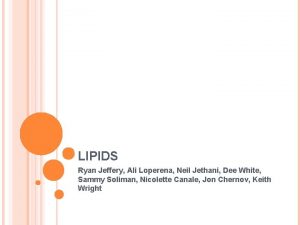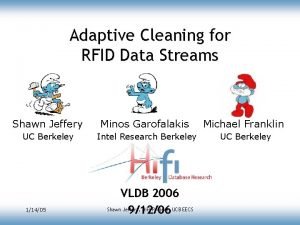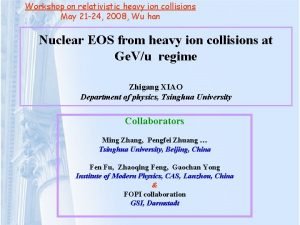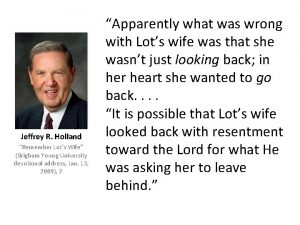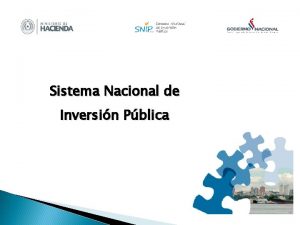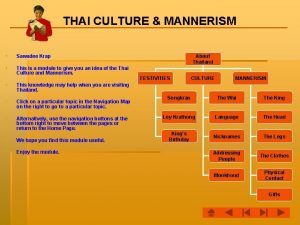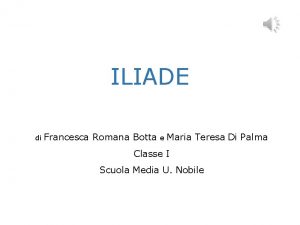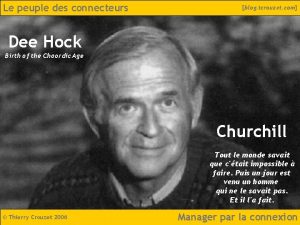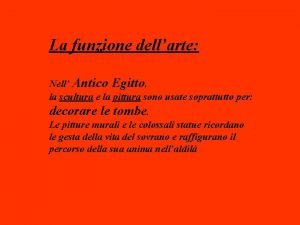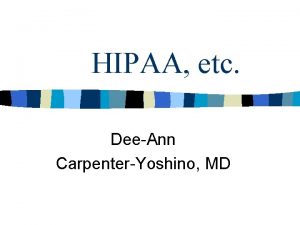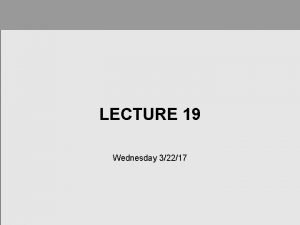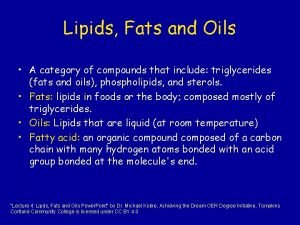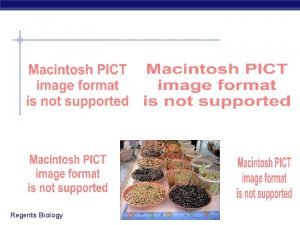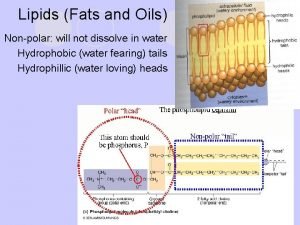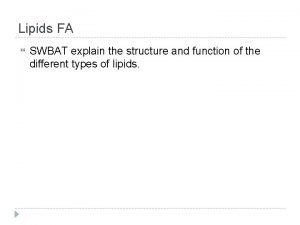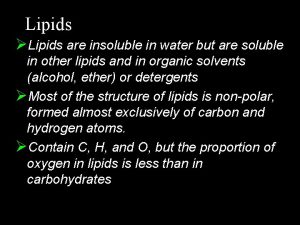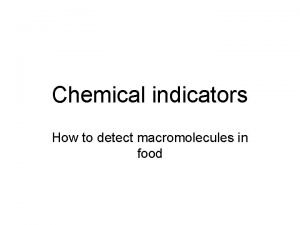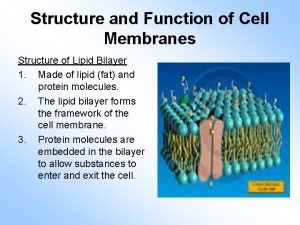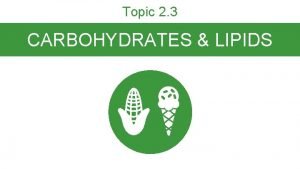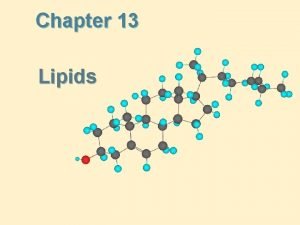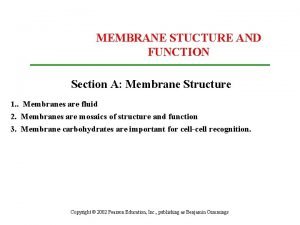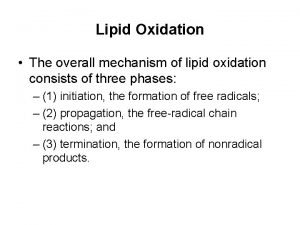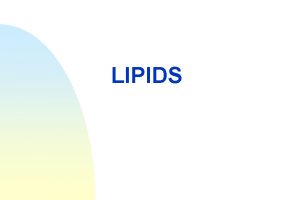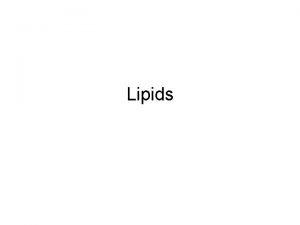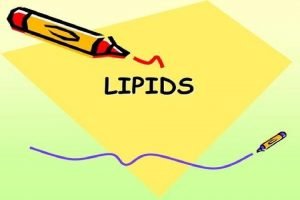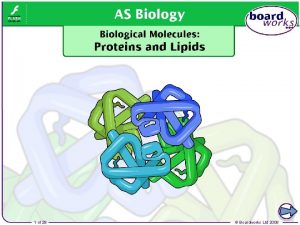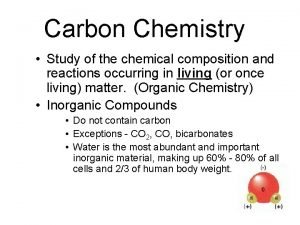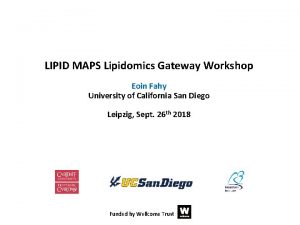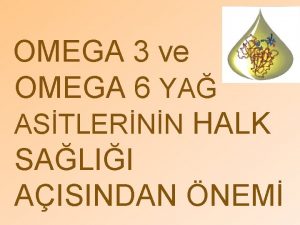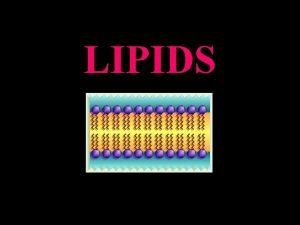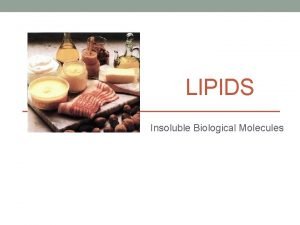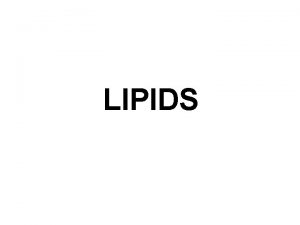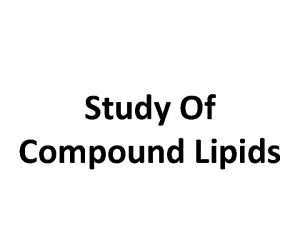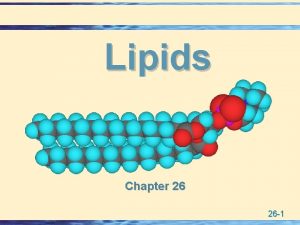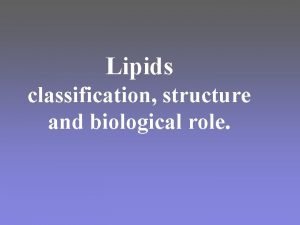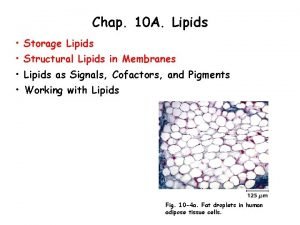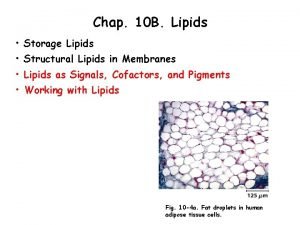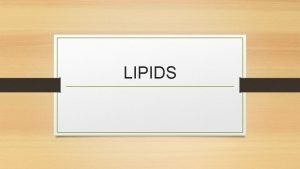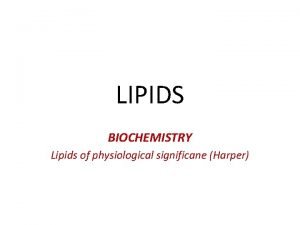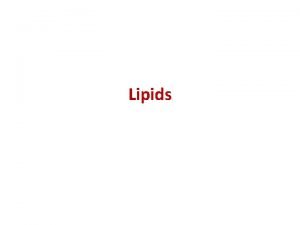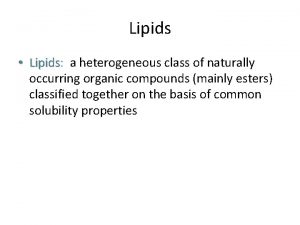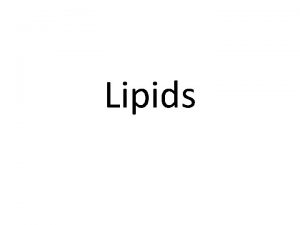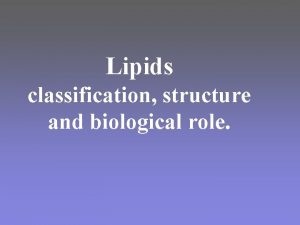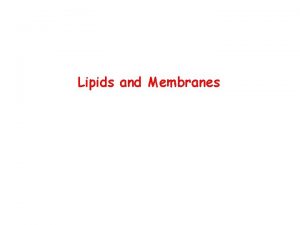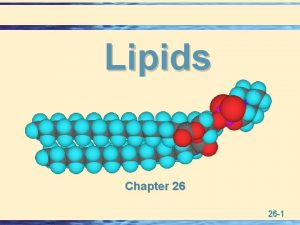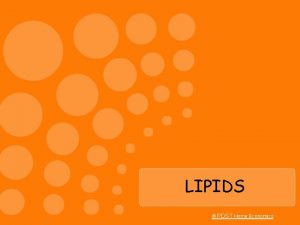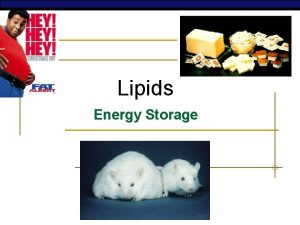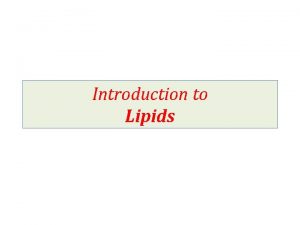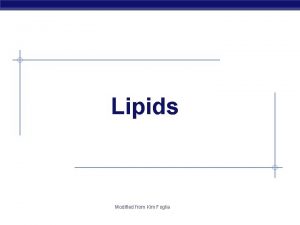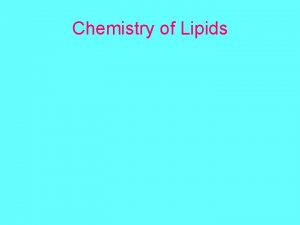LIPIDS Ryan Jeffery Ali Loperena Neil Jethani Dee


























































- Slides: 58

LIPIDS Ryan Jeffery, Ali Loperena, Neil Jethani, Dee White, Sammy Soliman, Nicolette Canale, Jon Chernov, Keith Wright

OBJECTIVE B. 4. 1 Ryan Jeffery

WELCOME BACK! It’s very nice to see you all again! Now let’s get to work

OBJECTIVE 4. 1 Assessment Statement Compare the composition of the three types of lipids found in the human body. Teacher’s Notes Examples include triglycerides (fats and oils), phospholipids (lecithin), and steroids (cholesterol).

TRIGLYCERIDES Fatty Acid Chains can very in length! Chains are always EVENLY numbered in length!

COMPOSITION OF A TRIGLYCERIDE Triglycerides have two parts Glycerol Fatty Acids Glycerol Seen in Green 3 Carbon atoms bonded to 3 Hydroxyl Groups Fatty Acids Carboxyl group Bonded to a hydrocarbon chain approximately 16 to 18 carbons long

EXAMPLES Fat Molecules and Oils Both are found in abundance in fast food Both are linked to an increased risk of heart disease and stroke.

PHOSPHOLIPIDS Choline Group Glycerol Fatty Acid Chain

PHOSPHOLIPIDS Make up most of the plasma membrane PHOSPHOLIPID Bi-layer First discovered in egg yolk by Theodore Nicolas in 1847

LECITHIN First phospholipid discovered Specifically Phosphatidylcholine Composed of: Glycerophosphoric Acid (one saturated, one unsaturated fatty acid) Choline Head Found in: Animal Tissue Plant Tissue Egg Yolks

STEROIDS*

STRUCTURE 20 Carbon Atoms Form Four Rings Three Cyclohexane rings (C 6 H 12) (A, B, C) One Cyclopentane ring (C 5 H 10) (D) Yes, that’s more than 20 C – They share Varying functional groups Varying oxidation states

CHOLESTEROL

OBJECTIVE B. 4. 2 Ali Loperena

B. 4. 2 OUTLINE THE DIFFERENCE BETWEEN HDL AND LDL CHOLESTEROL AND OUTLINE ITS IMPORTANCE. • • Cholesterol has a four ring structure characteristic of all steroids. The structure of cholesterol is called the steroid backbone • • Look for this in the hormones section and in the medicines and drugs unit. Cholesterol is transported around the body by lipoproteins.

4. 2 OUTLINE THE DIFFERENCE BETWEEN HDL AND LDL CHOLESTEROL AND OUTLINE ITS IMPORTANCE. HDL LDL Full Name High Density Lipoproteins Low Density Lipoproteins Approximate Size 8 -11 nm 18 -24 nm • LDL transports cholesterol to the arteries where it lines the walls. Atherosclerosis (thickened arteries) can lead to cardiovascular disease. • Major sources of LDL are saturated fats. In particular those derived from lauric (C 12 ), mystiric (C 14 ), and palmitic (C 16 ). • HDL can remove cholesterol from the arteries and transport it back to the liver.

OBJECTIVE B. 4. 3 Neil Jethani

B. 4. 3 DESCRIBE THE DIFFERENCE IN STRUCTURE BETWEEN SATURATED AND UNSATURATED FATTY ACIDS. SATURATED- carboxyl group connected to ONLY single bonded C atoms bonded to H atoms. (C-C) UNSATURATED- carboxyl group connected to c atoms with at least one group of double bonded C atoms. (C=C) The double bond causes fats (ex. triglyceerides) to have a lower melting/boiling point-the double bond tends to keep the fat flat-linear----usually oils at room temp Steric effect (relevant to shape): the interjection of double bonded C atoms prevent the fatty acid molecules from approaching each other closely and hence interacting via Van der Waals’ forces.

B. 4. 3 DESCRIBE THE DIFFERENCE IN STRUCTURE BETWEEN SATURATED AND UNSATURATED FATTY ACIDS. Most naturally occurring fats and oils contain a mixture of saturated, mono-unsaturated and polyunsaturated fatty acids and are classified according to the predominant type in the mixture. Examples: Unsaturated: Linseed soil (flax plant) has a low percentage of saturated fatty acid. Vegetable lipids are usually unsaturated Saturated: Beef tallow (from beef fat) has a high percentage of saturated fatty acids. Animal lipids tend to be saturated

B. 4. 3 DESCRIBE THE DIFFERENCE IN STRUCTURE BETWEEN SATURATED AND UNSATURATED FATTY ACIDS. SATURATED UNSATURATED

B. 4. 3 DESCRIBE THE DIFFERENCE IN STRUCTURE BETWEEN SATURATED AND UNSATURATED FATTY ACIDS. Summative Table Type Molec. Structure Phys. Structure Van der Waals Melting Points Saturated All single bonds C Straight chains -C Greater (more High (solid at atoms) stronger room temp) interaction Unsaturated One C=C (mono-) Double-bonds or several C=C kinked chain (poly-) Lesser (fewer atoms) weaker interaction Low (liquid at room temp)

OBJECTIVE B. 4. 4 Dee White

B. 4. 4 COMPARE THE STRUCTURES OF THE TWO ESSENTIAL FATTY ACIDS LINOLEIC (OMEGA– 6 FATTY ACID) AND LINOLENIC (OMEGA– 3 FATTY ACID) AND STATE THEIR IMPORTANCE. Linolenic (omega-3 fatty acid) Linoleic (omega-6 fatty acid) Poly-unsaturated fatty acid Carboxylic acid with an 18 carbon Carboxylic acid with an 18 chain and three cis double bonds carbon chain and two cis double bonds (C=C) cis means on the same side The first double bond is located at at the sixth carbon from the third carbon from the methyl end (aka- the omega end), the end) and the second is located at the sixth, and at the ninth. the third is located at the ninth.

omega end Carboxylic Acid

WHY SO IMPORTANT? Linoleic (omega-3 fatty acid) and Linolenic (omega-6 fatty acid) are ESSENTIAL for human health. We must have them in our diets because our metabolism cannot synthesize them from food components. A lack of omega-6 fatty acids causes dry hair, hair loss, and poor wound healing. Omega-3 fatty acids are thought to decrease the chances of cardiovascular diseases and prostate cancer. Both of these fatty acids are thought to help lower LDL cholesterol. Linoleic and linolenic are found in vegetable oils such as sunflower oil, poppy seed oil, corn oil, and canola oil; as well as in soybeans, hemp, and walnuts.

OBJECTIVE B. 4. 5 Ms M

B. 4. 5 DEFINE THE TERM IODINE NUMBER AND CALCULATE THE NUMBER OF C=C DOUBLE BONDS IN AN UNSATURATED FAT/OIL USING ADDITION REACTIONS.

OBJECTIVE B. 4. 6 Sammy Soliman

B. 4. 6 DESCRIBE THE CONDENSATION OF GLYCEROL AND THREE FATTY ACID MOLECULES TO MAKE A TRIGLYCERIDE (2) Glycerol: 3 -carbon backbone carbon 1 and 3 have two hydrogen and one hydroxyl group attached carbon 2 has one hydrogen and one hydroxyl group attached all bonds are covalent the hydroxyl groups are polar allowing for dipole-dipole interactions Fatty Acid: long carbon chain backbone all bonds are covalent and non-polar

B. 4. 6 DESCRIBE THE CONDENSATION OF GLYCEROL AND THREE FATTY ACID MOLECULES TO MAKE A TRIGLYCERIDE (2) Fatty Acid (continued): two types: Saturated – all single bonds (no more hydrogen atoms can be accepted) Unsaturated – at least one or more double bonds between carbon atoms (can accept at least or more hydrogen atoms making it saturated) Carbon 1 has a single bond with a hydroxyl group and a double bond with an oxygen (carboxyl group) Middle carbons have 2 hydrogen attached in saturated fats and can vary between two, one, or no hydrogen attached in unsaturated fats depending on the placement of double bonds End carbons have three hydrogen attached

B. 4. 6 DESCRIBE THE CONDENSATION OF GLYCEROL AND THREE FATTY ACID MOLECULES TO MAKE A TRIGLYCERIDE (2) Triglyceride: Composed of three fatty acids attached to one glycerol molecule via three separate ester bonds Formed by a condensation reaction Condensation Reaction: Requires three fatty acids and one glycerol The three fatty acids are bonded to the glycerol molecule through a process known as esterification The hydroxyl groups of the glycerol and the hydrogen in the hydroxyl groups of the acids are lost during the process Each oxygen from the hydroxyl groups of the fatty acids are then bonded to a separate carbon of the glycerol by an ester bond forming a triglyceride

B. 4. 6 DESCRIBE THE CONDENSATION OF GLYCEROL AND THREE FATTY ACID MOLECULES TO MAKE A TRIGLYCERIDE (2) Condensation Reaction (continued): The three hydroxyl groups and the three hydrogen atoms that were lost form three water molecules (the reason the reaction is called a condensation reaction)

B. 4. 6 DESCRIBE THE CONDENSATION OF GLYCEROL AND THREE FATTY ACID MOLECULES TO MAKE A TRIGLYCERIDE (2) Hydroxyl Group Fatty Acid Tail Glycerol Carboxyl Group Ester bond Triglyceride

B. 4. 6 DESCRIBE THE CONDENSATION OF GLYCEROL AND THREE FATTY ACID MOLECULES TO MAKE A TRIGLYCERIDE (2) Condensation Reaction

OBJECTIVE B. 4. 7 Nicolette Canale

B. 4. 7 DESCRIBE THE ENZYME-CATALYSED HYDROLYSIS OF TRIGLYCERIDES DURING DIGESTION Essentially the reverse of B. 4. 6 During digestion Triglycerides broken down (hydrolyzed) by enzymes (lipases) glycerol and fatty acids In turn these are broken down by a series of redox reactions carbon dioxide, water, and energy

B. 4. 7

OBJECTIVE B. 4. 8 Jonathan Chernov

B. 4. 8 EXPLAIN THE HIGHER ENERGY VALUE OF FATS AS COMPARED TO CARBOHYDRATES (3) Fats: Long hydrocarbon chains; most of the mass in a fatty acid or triglyceride is from carbon, and a small percentage is from oxygen Ex: C 18 H 38 O 6 Carbohydrates: Contain equal proportions of carbon and oxygen and twice as much hydrogen atoms Ex: C 6 H 12 O 6 (fructose) When fats and carbohydrates are metabolized, the main products are CO 2 and H 2 O The carbon and hydrogen form strong bonds with oxygen which result in the large release of energy

B. 4. 8 EXPLAIN THE HIGHER ENERGY VALUE OF FATS AS COMPARED TO CARBOHYDRATES Reason: Amount of oxidation that takes place as the compounds are converted to CO 2 and H 2 O Fats require more oxidation to be converted than carbohydrates Carbohydrates have one oxygen atom for every carbon atom, so each carbon atom needs only one more oxygen and each pair of hydrogen atoms need one more oxygen In fats most carbons are bonded to hydrogen atoms, so when fats are metabolized they form more new C-O bonds, releasing more energy than carbohydrates Carbohydrates make fewer C-O bonds because the bonds already exist Each carbon atom needs two oxygen atoms instead of one, while each hydrogen needs one oxygen The bond enthalpy of the C-O bond is high, so when it forms a large amount of energy is released Fat molecules require about half as much oxygen for the same number of carbon atoms Oxidation of fats is longer, but produces more energy

B. 4. 8 EXPLAIN THE HIGHER ENERGY VALUE OF FATS AS COMPARED TO CARBOHYDRATES When comparing fats and carbohydrates gram to gram: More oxygen is included in the weight of a carbohydrate Fats have more carbon atoms per gram when weighed, which means they will release about twice as much energy as carbohydrates Fats: 9 kilocalories/gram Carbohydrates: 4 kilocalories/gram

B. 4. 8 EXPLAIN THE HIGHER ENERGY VALUE OF FATS AS COMPARED TO CARBOHYDRATES Examples of metabolization reactions: Fat: O 2 + C 58 H 112 O 6 CO 2 + H 2 O + energy Carbohydrate: C 6 H 12 O 6 + 6 O 2 6 CO 2 + 6 H 2 O + energy

OBJECTIVE B. 4. 9 Keith Wright

OBJECTIVE B. 4. 9 Describe the important roles of lipids in the human body and the negative effects that can have on health.

MEMBRANES Lipids compose the selectively-permeable membranes required for diffusion. Phospholipids consist of a polar, hydrophilic phosphate ‘head’ and two hydrophobic fatty acid ‘tails’.

MEMBRANES The fact that one end of the phospholipid will always point toward water and one will always point away creates the structure of the phospholipid bilayer.

ENERGY STORAGE • • Triglyceride lipids are used to store energy. Because three hydrocarbon chains of a triglyceride are hydrophobic, they remain stable in the presence of less water. Thus, lipids require only one-sixth the amount of water to be activated that glycogen does. When fully metabolised, one triglyceride yields NADH, FADH 2 and Acetyl Co. A, which are used in Cellular Respiration to produce 14 ATP.

STEROIDS Steroid Hormones are cholesterol-based molecules that are used in cell-signalling. Steroids consist of the cyclohexane rings and one cyclopentane ring, to which various functional groups are attatched.

STEROIDS Steroids act by binding to surface proteins on the cell membrane, or in the cytoplasm. The hormoneprotein complex enters the nucleus and binds to a specific gene sequence, increasing or decreasing the frequency of transcription. Video: http: //www. youtube. com/watch? v=o. Oj 04 Ws. U 9 ko

INSULATION Lipids are natural insulators. Lipids are covalent compounds that do not conduct heat or electricity easily. Lipid-filled cells called adipocytes found in the subcutaneous layer of skin for an insular barrier to help maintain body temperature.

HEALTH EFFECTS

Ω-3 FATTY ACIDS Ω-3 s are unsaturated hydrocarbon chains that have a carbon double-bond from the third Carbon down. Certain Ω-3 s reduce the risk of heart disease by increasing circulation and breaking down the fibrin protein responsible for bloodclots. This clears the blood vessels and lightens the heart’s workload, thus decreasing the risk of heart attack and heart disease.

CHOLESTEROL & LDLS Cholesterol is a steroid that is important for biomolecular synthesis and membrane fluidity. LDL is a small lipoprotein containing cholesterol. A high-cholesterol diet can result in a high concentration of LDLs in the bloodstream. These LDLs accumulate on the walls of arteries, where they harden and obstruct bloodflow.

CHOLESTEROL & LDL

OBESITY Obesity is the excess accumulation of body fat. Energy-rich carbohydrates and lipids from the diet that are not metabolised are stored as lipids in the adipocytes. Increased need for lipid storage leads to the growth of more adipose tissue, increasing body mass.

OBESITY This increased body mass and weight puts strain on the heart, joints, and skeleton, resulting in increased risk of heart disease, arthritis, and thrombosis. Increased lipid concentration hampers the functioning of the liver, kidneys, and brain.

FATTY LIVER DISEASE

OTHER DISEASES Gallstones Osteoarthritis Chronic Acid Reflux
 Nicolette canale
Nicolette canale Jeffery ha
Jeffery ha Dr stephen jeffery
Dr stephen jeffery Al shawn jeffery
Al shawn jeffery Jeffery
Jeffery Jeffrey schor
Jeffrey schor Jeffery klaehn
Jeffery klaehn Elder holland lot's wife
Elder holland lot's wife Fondos dee
Fondos dee Dee childs
Dee childs Dee trader opens a brokerage account
Dee trader opens a brokerage account Sawadee krap
Sawadee krap Dee ward hock
Dee ward hock Tre dee alla scuola media riassunto
Tre dee alla scuola media riassunto Dee ward hock
Dee ward hock Giz dee
Giz dee Dee horton and lew hewitt
Dee horton and lew hewitt Dee reul
Dee reul Dee gulati
Dee gulati Dee simmons young
Dee simmons young Conversational dashboard
Conversational dashboard Micerino tra due dee
Micerino tra due dee Topical agents definition
Topical agents definition Dee magnoni
Dee magnoni Dee hock
Dee hock Klein anna zat op blauwe steen
Klein anna zat op blauwe steen Casperwww.
Casperwww. Dee casper
Dee casper Nda full dac
Nda full dac Jane dee hull elementary
Jane dee hull elementary Frankie dee brown
Frankie dee brown Dr dee-ann carpenter
Dr dee-ann carpenter Dee kay buildcon pvt ltd
Dee kay buildcon pvt ltd Dee williams anal fuck
Dee williams anal fuck Fats are converted into
Fats are converted into Wednesday two of the key
Wednesday two of the key Lipids characteristics
Lipids characteristics Lipids
Lipids Are lipids hydrophobic
Are lipids hydrophobic Lipids example
Lipids example Are lipids insoluble in water
Are lipids insoluble in water How are indicators used to detect macromolecules?
How are indicators used to detect macromolecules? Lipids in cell membrane function
Lipids in cell membrane function Storage of carbohydrates
Storage of carbohydrates Complex lipids
Complex lipids Lipids hydrophobic or hydrophilic
Lipids hydrophobic or hydrophilic Oxidation of lipids
Oxidation of lipids Complex lipids
Complex lipids Fats and lipids
Fats and lipids Facts about lipids biology
Facts about lipids biology Essential non essential fatty acids
Essential non essential fatty acids Monomer and macromolecule
Monomer and macromolecule V
V Emulsion test for lipids
Emulsion test for lipids Ethanol emulsion test for lipids
Ethanol emulsion test for lipids Monomer in lipids
Monomer in lipids Lipidomics
Lipidomics Saponifiable lipids example
Saponifiable lipids example Araşidonik asit metabolizması
Araşidonik asit metabolizması
